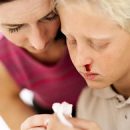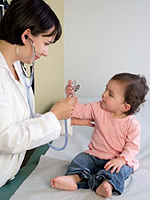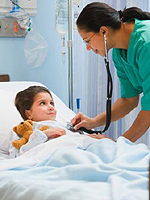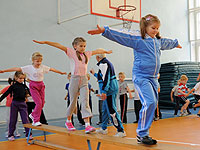Pyelonephritis in children, the reasons for which kidney parenchyma inflammation is a disease that arose against the background of a bacterial infection. Distinguish primary and secondary pyelonephritis in children. More about this in the article.
Content
Pyelonephritis in children, the reasons for which kidney parenchyma inflammation is a disease that arose against the background of a bacterial infection. Distinguish primary and secondary pyelonephritis in children. More about this in the article.
Causes of pyelonephritis in children
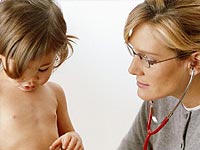 At the beginning of pyelonephritis in children, the reasons for which at an early age can be both congenital and acquired, indicate a number of signs and manifestations. Kids and adolescents are susceptible to a greater degree than adults, and girls have a inflammatory process at an early age occurs more often than that of boys. Today, doctors of pediatricians and urologists note the increasing cases of this microbial and inflammatory disease in newborns and infants. Among the probable messages in the occurrence of the disease, the decrease in immunity is noted, which is especially pronounced among the three age groups:
At the beginning of pyelonephritis in children, the reasons for which at an early age can be both congenital and acquired, indicate a number of signs and manifestations. Kids and adolescents are susceptible to a greater degree than adults, and girls have a inflammatory process at an early age occurs more often than that of boys. Today, doctors of pediatricians and urologists note the increasing cases of this microbial and inflammatory disease in newborns and infants. Among the probable messages in the occurrence of the disease, the decrease in immunity is noted, which is especially pronounced among the three age groups:
- from birth to 2 years;
- from 4 to 7 years;
- In adolescents during puberty.
A general reduction in the resistance of the children's body occurs also because treatment with antibiotics has acquired a global nature, it affected the weakening of the integer generation immunity. Another important factor is the absence in the urine of kids antimicrobial substances, it is known that kids up to 5 years are not able to completely empty the bladder, which leads to stagnation of urine and, accordingly, to reproduction of bacteria. At older age, the infection of infections from the mucous meal through the bottom departments of the urinary tract right into the kidneys. I should not forget about the foci of infection, which are long present in the children's body: caries, tonsillitis, sinusitis, etc. Sometimes the inflammation of the renal parenchyma can be a manifestation of intrauterine infection. The weighty argument in the occurrence of the disease is an intestinal wand, inhabiting in the middle of the zone, falling into the urinary system during the arms of little girls, it also provokes the occurrence of inflammation.
How not to miss the symptoms of pyelonephritis in children?
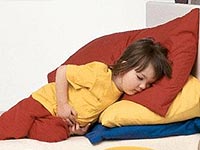 Depending on the area of the lesion, the right-hand and left-sided, acute and chronic pyelonephritis in children are distinguished. Symptoms of inflammation are manifested by pain in the abdomen and lower back, increasing body temperature, vomiting, feed from food, disruption of water and salt metabolism. Teens complain of headache, lethargy and general weakness, nausea, frequent urination, they describe painful well-being when changing the position of the body, due to slopes, bending, and even cough. With severe disease, the excretory function of the kidneys is disturbed, the extreme manifestation of the inflammatory process is infectious toxic shock. This condition, depending on the duration and acuteness of the developing picture, can lead to renal failure. Parents should be paid to the fact that sometimes the beginning of the disease can remain unnoticed that, unfortunately, it does not simplify the picture, but leads to the development of formidable complications. Thoughtful mom will surely notice a change in the well-being of the child, the forced position of the body in the form of a scoliosis, pulling the leg on the side of the lesion — All this will serve as a signal to an urgent appeal to a pediatrician doctor or a children's urologist. Inspection of a specialist and necessary laboratory studies, including blood test and urine, will make a conclusion about the change in the state of the kidneys and their function.
Depending on the area of the lesion, the right-hand and left-sided, acute and chronic pyelonephritis in children are distinguished. Symptoms of inflammation are manifested by pain in the abdomen and lower back, increasing body temperature, vomiting, feed from food, disruption of water and salt metabolism. Teens complain of headache, lethargy and general weakness, nausea, frequent urination, they describe painful well-being when changing the position of the body, due to slopes, bending, and even cough. With severe disease, the excretory function of the kidneys is disturbed, the extreme manifestation of the inflammatory process is infectious toxic shock. This condition, depending on the duration and acuteness of the developing picture, can lead to renal failure. Parents should be paid to the fact that sometimes the beginning of the disease can remain unnoticed that, unfortunately, it does not simplify the picture, but leads to the development of formidable complications. Thoughtful mom will surely notice a change in the well-being of the child, the forced position of the body in the form of a scoliosis, pulling the leg on the side of the lesion — All this will serve as a signal to an urgent appeal to a pediatrician doctor or a children's urologist. Inspection of a specialist and necessary laboratory studies, including blood test and urine, will make a conclusion about the change in the state of the kidneys and their function.
Secondary pyelonephritis in children — Increased attention zone
The diagnosis is especially difficult to put in infants and babies, it is much easier to the question of adolescents that can at least schematically state their condition and sensations. Basic diagnostic base — These are characteristic changes in general analysis of the urine and a typical clinical picture of the disease. Ultrasound examination of the urinary system organs helps to clarify congenital anatomical pathology and the presence of anomalies due to the possible development of secondary pyelonephritis in children, which is especially important when choosing treatment tactics. As you know, the primary version of the disease develops more often in healthy children, when there are no grounds for the development of urine stagnation. Certain hereditary and acquired diseases and vices, for example, violation of the structure of the bladder, ureterals, polycystic disease of the kidneys, hydronephrosis in particular on the background of chronic tonsillitis, infection of sexual and urinary organs, multiple carious cavities can be a starting mechanism in the launch of secondary inflammatory kidney lesion.


